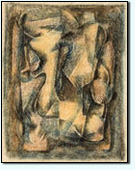Publications
Reminiscences > Ary and Music
“He seemed drained of all creative energy; once in awhile he would take up his brushes listlessly and try to paint, but there was nothing ready to bring forth.”
Music was Ary's love, after painting. He was an avid concert-goer, and in his New York studio he always had the radio tuned to the music stations as he worked. He didn't know one note from another, but he usually could recognize any composer he had heard to any extent, through the structure of the composition. I found it interesting to note the reviews in which his paintings were compared to music. Of course the paintings mentioned were named after they were painted, simply for exhibition purposes, since the public likes a title. Ary never consciously tried to translate music into painting. However he would often say to people who were seeking some explanation of his abstractions, "Look at them the way you listen to music." In other words, don't seek a literary connotation; this is an abstract art like music.
From New York press:
"These new compositions bear a direct relation to music and might appropriately be called tone poems. A number of them are on Indian themes, including the large Indian Legend, with shimmering water suggested in the foreground, moving back and around, but always within the picture frame."
The Art Digest
February 15, 1946
"... a style dominated by a new lyric use of color and aiming at suggestion rather than representation. Paintings on Indian themes remind one of music, as for example, Sibelius "
New York Times
February 24, 1946
"... I use colors like a composer uses musical notes,' he says, and although he has no actual system of color-and-sound counterparts, as some extreme theorists have attempted, Stillman’s paintings do remind one of the emotional overtones of certain musical compositions."
Pictures on Exhibit
February 1949
"…Some titles, such as 'Jazz,' indicate that certain ones have been inspired by hearing music…"
New York Times
January 29, 1950
"Ary Stillman's current exhibition asserts again how well an abstract style can serve lyrical statement and enrich the evocative image… Musical themes inspire these paintings, and without descending to trite analogies, they successfully translate the intangibles of one art form into another. Overture, for example, captures the rising sense of promising beginnings that such a musical composition can offer…"
The Art Digest
February 1, 1950
"…Designed, for the most part, on musical themes (some of his titles are "Obligato," "Overture," and "Jazz,") the handsome new canvases are rhythmical in pattern, so composed that the well-defined shapes hold together in almost magnetic fashion."
New York Herald-Tribune
January 26, 1950
"... the rippling cadences with which he defines a mass of form eliciting a sensation of movement…"
New York Herald-Tribune
January 21, 1951
"...Stillman's linear patterns always have been decidedly musical. This year they are choppier than last, as if he had been listening to Bartok instead of Debussy."
James Fitzimmons of Art Digest (now editor of Art International)
January 15, 1952
"On the other hand, Ary Stillman’s paintings at the Bertha Schaefer Gallery carry abstraction deep into its 'romantic' phase. For him, plastic rhythms are a means of evoking poetic content. Color, refulgent and suggestive, stirs the visual imagination to respond to something beyond the world of pure shapes. Texture and technique are also used to this end...."
New York Times
January 27, 1952
Copyright © 2002-2007 The Stillman-Lack Foundation.
All text and images on this site may not be published, broadcast, or distributed in any form without the prior written permission of The Stillman-Lack Foundation.


